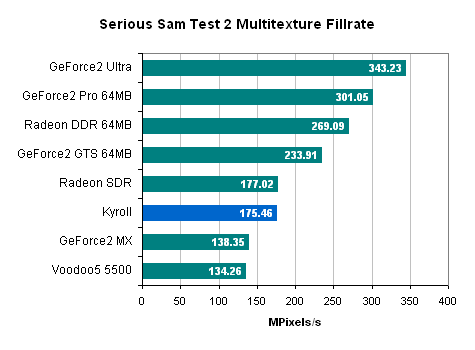Serious Sam Performance - Fill Rates
This review marks the addition of two new benchmarks into the AnandTech video card testing lineup. First we will take a look at Serious Sam, a game developed by Croteam that is currently in beta test form. The game, which features very impressive benchmarking features, can not only give the frame rates of game playback, but also the sustained frame rates as well as fill rates.

One tool that the Serious Sam engine possesses is the ability to measure the actual fill rate of a card. This has been something that we previously had not been able to do, meaning that we relied simply on manufacturers numbers. As the above shows, those numbers are extremely misleading.
Remember how we mentioned before that when overdraw is taken into account, the effective fill rate of a conventional video card is essentially the theoretical fill rate divided by the overdraw amount? Well, the Serious Sam tests show exactly this. Take the GeForce2 Ultra, for example. Theoretically, this card has a 1000 megapixel per second fill rate given its clock speed and rendering pipe. What we see in actuality, however, is that the GeForce2 Ultra is only able to fill 375 megapixels per second. This means that given the synthetic Serious Sam fill rate tests, the GeForce2 Ultra is only 37.5% effective. One can attribute this to overdraw as well a memory bandwidth limitations
The Kyro II, on the other hand, features what many would consider a lowly 350 megapixel per second fill rate. However, when the tests are run, the Kyro II scores a fill rate that is only 22 megapixels per second less than the GeForce2 Ultra. Coming out at 352.89 megapixels per second, the Kyro II's effective fill rate matches its theoretical fill rate, something we cannot say about any other card on the market. According to the Serious Sam benchmarks, the Kyro II is actually 100% efficient.
This is quite exciting to see. Previous fill rate numbers have been misleading, to say the least. The Kyro II's tile based rendering architecture, however, opens a new path in fill rates where effective fill rates actually match theoretical ones. Can you imagine a Kyro II card that actually featured the theoretical fill rate of 1000 megapixels per second that the GeForce2 Ultra features? Out of this world would be the only way to describe it.

The focus of the Serious Sam synthetic benchmark should be to observe fill rate efficiency, as the benchmark assumes a certain amount of overdraw that may or may not be present in actual game play. With this in mind, let's see how the Kyro II fares in the mulitexture fillrate benchmark in terms of efficiency
The fact that the Kyro II is able to hit 175 megapixels per second shows that once again that the Kyro is 100% efficient. In the case of the multitexture benchmark, it seems that 2 textures are applied to the polygons being rendered. This would bring the fill rate of the Kyro II down to 175 megapixels per second, exactly the score it is able to get.
As we pointed out before, the ability to reach 100% efficiency in this synthetic test says a great deal about the promise of tile based rendering. No longer will theoretical fill rates never see the light of day, as the Kyro II and its tile based architecture allows for effective fill rates to match theoretical ones.










4 Comments
View All Comments
MonkeyPaw - Monday, February 24, 2014 - link
Thanks for the stroll down memory lane (by keeping the article up). I had one of these cards back in 2002, and it was one I looked back upon fondly. I can't remember most of the GPUs I owned from yesteryear, save the Voodoo 3 and the crappy S3 Verge. That's fairly elite company, at least in my brain, anyway. :)xrror - Monday, March 2, 2015 - link
Yea, it's sad that there wasn't any further development of the Kyro series in the PC market. If I remember right (probably needs fact checked) Imagination's development resources got sucked into the Sega Dreamcast after this point. Even that wouldn't have been so bad if Sega hadn't just given up on the Dreamcast so early on due to a "poor showing in Japan" (nevermind everyone loved it in the US but we didn't count apparently, also see Genesis/MegaDrive).I think Imagination or at least their tech lives on in the embedded/mobile space now, but meh - really wanted to see what they could have done with their tech without being shackled to a power budget in 2002-2005 era PC's.
Alexvrb - Wednesday, October 14, 2020 - link
You're wrong. The Dreamcast was designed years earlier using PowerVR Series 2. The later "Kyro series" was based on Series 3. The DC design win netted them some much needed cash which they used to fuel their Series 3 releases. What killed imgtech was their inability to play well with others (board partners) and issues staying on schedule for releases. If they had managed to get the 4800 out the door sooner, and released the larger Kyro III with DDR it would have bought them some time. Especially if they had paired it with a hardware T&L block like Elan.thegreatjombi - Wednesday, August 12, 2015 - link
Its very interesting to think that Imagination Technologies could have been another foot note in history (3dfx, bitboys Oy! Rendition..) but going mobile and refining their technology has allowed them to basically become more popular than ATI(AMD) or Nvidia. There are probably more devices in peoples houses running a powervr variant than have an AMD or Nvidia GPU.I do wish someone would stick their chip on a discrete card again, they apparently support full Directx and OpenGL! could be an interesting low profile, low end, low power, fanless card for HTPCs.